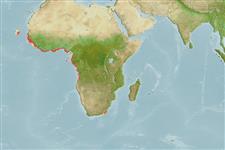>
Eupercaria/misc (Various families in series Eupercaria) >
Haemulidae (Grunts) > Haemulinae
Etymology: Pomadasys: Greek, poma, -atos = cover, operculum + Greek, dasys = with hair (Ref. 45335).
More on author: Cuvier.
Environment: milieu / climate zone / depth range / distribution range
Écologie
marin; saumâtre benthopélagique; profondeur 25 - 90 m (Ref. 27000). Tropical
Eastern Atlantic: west coast of Africa, from Senegal to Angola (Ref. 57395). Also reported from Mauritania (Ref. 5377).
Taille / Poids / Âge
Maturity: Lm ? range ? - ? cm
Max length : 60.0 cm TL mâle / non sexé; (Ref. 57395); common length : 45.0 cm TL mâle / non sexé; (Ref. 2683)
Épines dorsales (Total) : 12; Rayons mous dorsaux (Total) : 15; Épines anales: 3; Rayons mous anaux: 10. Diagnosis: body oblong and compressed, rather elongate; head profile straight before nape; snout pointed, distinctly longer than eye diameter; 2 anterior pores on chin, followed by a median pit bearing openings of another pair of pores (Ref. 57395). 2nd anal fin spine usually shorter than 3rd (Ref. 57395, 81655). Caudal fin deeply forked; scales ctenoid; 6-7 scale rows between lateral line and middle of spinous dorsal-fin base (Ref. 57395). No pore above posterior end of maxilla and under preorbital bone (Ref. 81655).
Coloration: silvery with small dark spots forming a pattern of wavy lines on back and sides; fins greyish, dorsal black at base; a yellow-golden spot on snout (Ref. 57395).
Inhabits coastal waters (Ref. 2683, 57395) close to the bottom (Ref. 57395). Occasionally enters estuaries (Ref. 2135, 57395) and other brackish water areas (Ref. 57395).
Life cycle and mating behavior
Maturities | Reproduction | Spawnings | Egg(s) | Fecundities | Larves
Oviparous, distinct pairing during breeding (Ref. 205).
Roux, C., 1990. Haemulidae. p. 783-788. In J.C. Quero, J.C. Hureau, C. Karrer, A. Post and L. Saldanha (eds.) Check-list of the fishes of the eastern tropical Atlantic (CLOFETA). JNICT, Lisbon; SEI, Paris; and UNESCO, Paris. Vol. 2. (Ref. 6946)
Statut dans la liste rouge de l'IUCN (Ref. 130435)
Menace pour l'homme
Harmless
Utilisations par l'homme
Pêcheries: commercial
Outils
Articles particuliers
Télécharger en XML
Sources Internet
Estimates based on models
Preferred temperature (Ref.
123201): 18.5 - 25.8, mean 19.9 °C (based on 31 cells).
Phylogenetic diversity index (Ref.
82804): PD
50 = 0.5000 [Uniqueness, from 0.5 = low to 2.0 = high].
Bayesian length-weight: a=0.01318 (0.00701 - 0.02480), b=2.99 (2.83 - 3.15), in cm total length, based on LWR estimates for this species & Genus-body shape (Ref.
93245).
Niveau trophique (Ref.
69278): 3.6 ±0.50 se; based on food items.
Résilience (Ref.
120179): Milieu, temps minimum de doublement de population : 1,4 à 4,4 années (Preliminary K or Fecundity.).
Fishing Vulnerability (Ref.
59153): Moderate vulnerability (44 of 100).
Nutrients (Ref.
124155): Calcium = 66.8 [14.7, 131.5] mg/100g; Iron = 0.731 [0.377, 1.420] mg/100g; Protein = 18.2 [16.4, 20.0] %; Omega3 = 0.226 [0.105, 0.399] g/100g; Selenium = 63.4 [33.2, 112.1] μg/100g; VitaminA = 26.9 [11.6, 60.2] μg/100g; Zinc = 1.31 [0.91, 1.88] mg/100g (wet weight);
